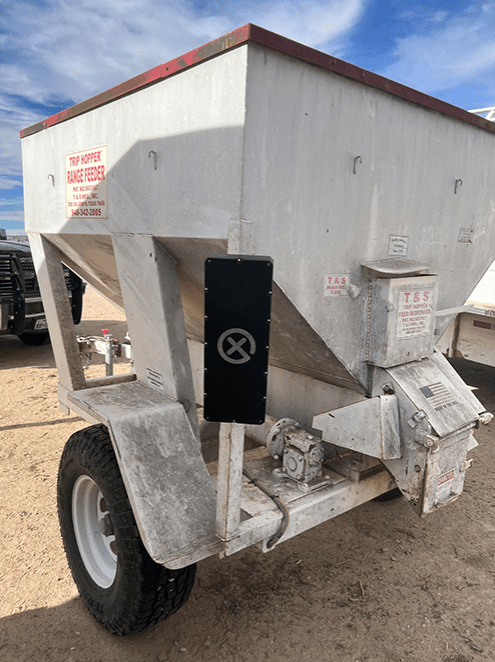By Claire Swedberg
Ranchers are tracking the movements of their livestock with a smart reader from HerdX that can be mounted on poles or vehicles to create temporary read zones in pastures or at water tanks.
Jun 11, 2023
Cattle ranchers have begun deploying a new ultrahigh-frequency (UHF) radio frequency identification (RFID) reader as part of a cattle-management solution that enables them to capture the location and identify of each animal as herds are rotated from one grazing area to another, or as animals drink, eat or are weighed. The solution, provided by Texas-based agriculture technology company HerdX, most recently includes the HerdView Smart Reader (HSR), an RFID Journal Awards finalist in the Best New Products category at last month’s RFID Journal LIVE! conference in Orlando, Fla.
The company developed the HSR solution to provide ranchers with a way to read tags in outdoor, rugged, and temporary environments, such as when cattle are moved to greener pastures. The technology is designed not only with a high-speed RFID reader and a built-in antenna, but also with Bluetooth and cellular connectivity, solar power, meshing functionality and ports to add additional antennas, according to Ken Burroughs, HerdX’s CEO.

The reader is configured for use with HerdX’s Intelligent Area Monitoring software and HerdView app, the company reports, to serve as a full animal monitoring and traceability solution. One purpose of the HSR system is to bring RFID technology to locations not typically conducive to wired equipment. That includes far-reaching fields, active and crowded cattle facilities, and chutes where both weather and large animals can create a variety of hazards.
Cattle farmers and ranchers face unique challenges since their assets are active and unpredictable, making identification and counting difficult even under the best of conditions. Traditional visual and barcoded tags require labor and are prone to errors, HerdX explains, so RFID technology has been offering a solution, traditionally with low-frequency (LF) RFID tags that can be scanned at relatively close range using dedicated RFID readers that are typically handheld.
Durability in Challenging Environments
HerdX says it takes an approach aimed at tracking animals while they are in motion, at a distance of up to 15 feet or more. By tagging cattle with UHF RFID tags, and by mounting readers at key locations, such as chutes through which cattle travel, users of the company’s solution can gain information about each cow without requiring them to stop or pass single-file near a reader.
The ranching world requires some flexibility, however, as cattle may be grazing in pastures that are rotated on a weekly or daily basis. In that way, grass and other vegetation has time to regrow before grazing continues.
With rotating pastures, the infrastructure through which cattle are herded is continually moving, and it thus requires a reader that can be easily mounted, or be taken down and reinstalled elsewhere. “That’s where the idea for the HSR came from,” Burroughs says.

With the HerdX solution, farmers or ranchers typically apply a UHF RFID tag to a cow’s ear. The tag comes encoded with a unique ID number, and they can scan the QR code on the tag to link the RFID identifier to details about the animal in the software. The system enables them to monitor animal movements in order to identify health anomalies on a daily basis. The mobile HSR RFID reader can be mounted with a bracket within about 20 to 30 minutes, wherever cattle tracking is required. That can change from day to day as the cattle are moved, and the system can be easily removed with a single bolt.

Ken Burroughs
Each time tags come within range of the reader, it captures those tags’ ID numbers and forwards that data to the cloud-based software via a cellular connection. The solution provides visibility via a dashboard, and it can allow analytics so that users can receive alerts, as well as pull up a dashboard for the most recent data related to their cattle, based on RFID tag reads. For instance, if a specific animal’s tag has not been read, or if it has not been detected as often at a water tank as would be expected for a healthy cow, the software will forward a notification to authorized parties via their smartphones.
In addition to these notifications, users can capture analysis to make decisions regarding their cattle, such as the impact of hydration on the animals’ weight gain over time. One user of the technology in North Texas manages approximately 4,500 cattle, which are moved daily to new grasses that the animals have not recently grazed. To move a herd of cattle, users raise and then readjust the electric fences that define the herd’s grazing area. The ranch moves a water tank in place as well.
Traditionally, ranchers have hand-counted cattle, read their printed name tags when necessary, and filled out stacks of paperwork regarding how the animals were faring as they moved from one pasture to another. Now, however, the ranchers can capture data with the HSR reader, and the device can be mounted to a pole above the watering trough. In addition, a ranch can mount the reader on a truck, or on the water trailer pulled behind the vehicle, to bring it directly to the location where the cattle are.
Reporting Every 24 Hours
As ranchers seek automated solutions for cattle management, Burroughs says, “Nobody has what we have, which is basically plug-and-play, with a unit that’s very portable.” The device weighs approximately 10 pounds, he says, and includes an AV connection where power is available, or a rechargeable battery for solar power.
The unit is ruggedized, Burroughs adds, so that it can withstand weather extremes and the general abuse that can come with the environment, “We’ve even had horses step on them,” he states, adding that the unit can sustain such hard knocks. “Our goal is that we offer a product that can survive all of that [abuse] and keep on ticking.”

HerdX provides a 24-hour cycle report that includes analytics and a bell curve showing the activities of a herd and each animal. That data can include when an animal arrived onsite, how often it eats and drinks, when it was moved, and a comparison of its weight based on those activities. The system can also update the status of a particular animal in a herd, such as adding vaccination or quarantine data, or transporting it to a harvesting facility or another location. What’s more, the capturing of weight data can be automated in the RFID system if the reader is used at the chute through which the animal travels.
For ranchers, Burroughs says, “We’re basically there as a tool for them to increase their productivity overall,” and to lower costs associated with managing and monitoring livestock, while ensuring the animals reach the weight required to be sold at the highest price. The technology can be used after cattle are transported as well, to ensure they manage the stress of that transfer well. For instance, after being loaded into the back of a truck, the animals can experience enough stress that when they are released at the new site, they need to be more closely monitored.
Cattle are expected to eat and drink shortly after reaching a new destination, so if they are not detected doing so, that could signal a potential problem. Users can also employ a HerdX handheld reader in Geiger counter mode to locate a specific animal. The RFID technology can then identify any behaviors that might indicate the animal requires attention. Data can be sent in the form of alerts, while ranchers using their mobile phones or tablets can access that information via the app while in the field. The HSR mobile reader’s Bluetooth functionality enables it to transmit read data to such mobile devices within its vicinity, even if there is no cellular connectivity.
In the future, the technology company plans to offer a satellite version of its readers for sites lacking a reliable cellular connection. The readers can also form a mesh network, so that two device could be deployed at a site at which animals may move especially fast, in a crowd or through a relatively wide area, to be sure no tag ID is missed. In the long term, the company plans to create a solution that can track a cow’s entire lifespan, and to create a link to the subsequent packaged meat sold at stores.
“We started the company to track and trace not only animals, but packaged meat,” Burroughs recalls, so that an RFID tag in an animal’s ear could be linked to a new tag ID on each package of beef for complete traceability. That full farm-to-fork approach will enable retailers and consumers to view where a meat product came from, he notes, including how the animal was treated, as well as when and under what conditions. The solution costs ranchers $4.99 per animal per tag, with inclusion in the software for a monthly fee. Burroughs says customers that benefit from the technology include small farms and cattle ranches, due to the low cost of entry.
Key Takeaways:
- HerdX’s HerdView Smart Reader can be mounted on a pole, beam or truck within a half-hour or less, and then begin reading the tags of cattle, even in remote grasslands.
- The company may eventually offer an RFID solution that tracks cows from birth to slaughter, as well as cuts of meat, so that consumers, retailers and producers can trace back a particular animal, along with its health and treatments.
